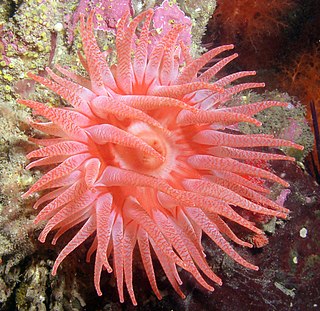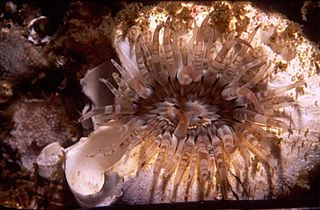
Anemonia sulcata, or Mediterranean snakelocks sea anemone, is a species of sea anemone in the family Actiniidae from the Mediterranean Sea. Whether A. sulcata should be recognized as a synonym of A. viridis remains a matter of dispute.

Cribrinopsis fernaldi, also known as the crimson anemone, snakelock anemone, chevron-tentacle anemone and Fernald brooding anemone, is a sea anemone native to the Pacific Ocean off northwestern North America.

Sea anemones are a group of predatory marine invertebrates constituting the order Actiniaria. Because of their colourful appearance, they are named after the Anemone, a terrestrial flowering plant. Sea anemones are classified in the phylum Cnidaria, class Anthozoa, subclass Hexacorallia. As cnidarians, sea anemones are related to corals, jellyfish, tube-dwelling anemones, and Hydra. Unlike jellyfish, sea anemones do not have a medusa stage in their life cycle.

Corynactis annulata, or the strawberry anemone, is a bright pink colonial anthozoan similar in body form to sea anemones and scleractinian stony corals. This species is a solitary animal of the order Corallimorpharia.

Acanthonyx dentatus, the toothed decorator crab, is a species of crab in the family Inachidae.
The brooding anemone, Halianthella annularis, is a species of sea anemone in the family Halcampidae,.

Anthothoe chilensis, or striped anemone, is a species of sea anemones in the family Sagartiidae.

Anthostella stephensoni, the violet-spotted anemone, is a species of sea anemone in the family Actiniidae.

Bunodosoma capense, commonly known as the knobbly anemone, is a species of sea anemone in the family Actiniidae.

Anthopleura michaelseni, commonly known as the long-tentacled anemone or crevice anemone, is a species of sea anemone in the family Actiniidae. It is native to very shallow water round the coasts of southern Africa between Lüderitz and Durban.

Korsaranthus is a genus of sea anemones in the family Actiniidae. It is monotypic, being represented by the single species Korsaranthus natalensis, commonly known as the spinnaker anemone or the candy-striped anemone.

The sandy anemone is a species of sea anemone in the family Actiniidae. It is native to very shallow water round the coasts of southern Africa between Luderitz and Durban.

The walking anemone, also known as the hedgehog anemone or sock anemone, is a species of sea anemones in the order Actiniaria. It is the only member of its genus, Preactis.

The ring-tentacle anemone is a species of sea anemone in the family Isanthidae.

The Cape zoanthid is a species of zoanthid in the family Parazoanthidae.

The burrowing anemone is a species of tube-dwelling anemone in the family Cerianthidae.

Balanophyllia bonaespei is a species of solitary cup coral, a stony coral in the family Dendrophylliidae. It is an azooxanthellate species that does not contain symbiotic dinoflagellates in its tissues as most corals do.

Carybdea murrayana, the South African box jellyfish, is a venomous species of cnidarian, in the small family Carybdeidae within the class Cubozoa.

Diadumene cincta is a small and delicate, usually orange, sea anemone. It has a smooth slender column and up to 200 long tentacles, and normally grows to a length of up to 35 mm (1.4 in), with a base of 10 mm (0.4 in), but specimens twice this size have been recorded. Diadumene cincta is found in the northeastern Atlantic Ocean.

Actinothoe sphyrodeta, the sandalled anemone, is a small sea anemone in the family Sagartiidae. It is native to the northeastern Atlantic Ocean and is common on the north, west and south coasts of Britain. It is usually grey or whitish but may have an orange oral disc. The translucent white tentacles that grow around the edge of the oral disc can number up to 120.





















